I created a windows service with Asynchronous Server Socket. I installed windows service and trying to start but it seems to be failing with While loop. If remove while loop the windows service start but it does not receive any information(data) from client. can anyone please guide me in the right direction?
**program.cs**
namespace ServiceInterfaceHost
{
static class Program
{
/// <summary>
/// The main entry point for the application.
/// </summary>
static void Main()
{
ServiceBase[] ServicesToRun;
ServicesToRun = new ServiceBase[]
{
new TcpipService()
};
ServiceBase.Run(ServicesToRun);
}
}
}
**TcpipService.cs**
the below program invokes the Asynchronous server StartListening method.
namespace ServiceInterfaceHost
{
public partial class TcpipService: ServiceBase
{
public TcpipService()
{
InitializeComponent();
}
protected override void OnStart(string[] args)
{
try
{
AsynchronousSocketListener.StartListening();
}
catch(Exception ex)
{
}
}
protected override void OnStop()
{
}
}
}
**AsynchronousSocketListener.cs**
I got this from a Microsoft document. The following example program creates a server that receives connection requests from clients. The server is built with an asynchronous socket, so the execution of the server application is not suspended while it waits for a connection from a client.
using System;
using System.Net;
using System.Net.Sockets;
using System.Text;
using System.Threading;
namespace TcipIpServiceInterface
{
// State object for reading client data asynchronously
public class StateObject
{
// Size of receive buffer.
public const int BufferSize = 1024;
// Receive buffer.
public byte[] buffer = new byte[BufferSize];
// Received data string.
public StringBuilder sb = new StringBuilder();
// Client socket.
public Socket workSocket = null;
}
public class AsynchronousSocketListener
{
// Thread signal.
public static ManualResetEvent allDone = new ManualResetEvent(false);
public AsynchronousSocketListener()
{
}
public static void StartListening()
{
// Establish the local endpoint for the socket.
// The DNS name of the computer
// running the listener is "host.contoso.com".
IPHostEntry ipHostInfo = Dns.GetHostEntry(Dns.GetHostName());
IPAddress ipAddress = ipHostInfo.AddressList[0];
IPEndPoint localEndPoint = new IPEndPoint(ipAddress, 11000);
// Create a TCP/IP socket.
Socket listener = new Socket(ipAddress.AddressFamily,
SocketType.Stream, ProtocolType.Tcp );
// Bind the socket to the local endpoint and listen for incoming connections.
try {
listener.Bind(localEndPoint);
listener.Listen(100);
**while (true) {**
// Set the event to nonsignaled state.
allDone.Reset();
// Start an asynchronous socket to listen for connections.
Console.WriteLine("Waiting for a connection...");
listener.BeginAccept(
new AsyncCallback(AcceptCallback),
listener );
// Wait until a connection is made before continuing.
allDone.WaitOne();
}
} catch (Exception e) {
Console.WriteLine(e.ToString());
}
Console.WriteLine("\nPress ENTER to continue...");
Console.Read();
}
public static void AcceptCallback(IAsyncResult ar)
{
// Signal the main thread to continue.
allDone.Set();
// Get the socket that handles the client request.
Socket listener = (Socket) ar.AsyncState;
Socket handler = listener.EndAccept(ar);
// Create the state object.
StateObject state = new StateObject();
state.workSocket = handler;
handler.BeginReceive( state.buffer, 0, StateObject.BufferSize, 0,
new AsyncCallback(ReadCallback), state);
}
public static void ReadCallback(IAsyncResult ar)
{
String content = String.Empty;
// Retrieve the state object and the handler socket
// from the asynchronous state object.
StateObject state = (StateObject) ar.AsyncState;
Socket handler = state.workSocket;
// Read data from the client socket.
int bytesRead = handler.EndReceive(ar);
if (bytesRead > 0) {
// There might be more data, so store the data received so far.
state.sb.Append(Encoding.ASCII.GetString(
state.buffer, 0, bytesRead));
// Check for end-of-file tag. If it is not there, read
// more data.
content = state.sb.ToString();
if (content.IndexOf("<EOF>") > -1) {
// All the data has been read from the
// client. Display it on the console.
Console.WriteLine("Read {0} bytes from socket. \n Data : {1}",
content.Length, content );
// Echo the data back to the client.
Send(handler, content);
} else {
// Not all data received. Get more.
handler.BeginReceive(state.buffer, 0, StateObject.BufferSize, 0,
new AsyncCallback(ReadCallback), state);
}
}
}
private static void Send(Socket handler, String data)
{
// Convert the string data to byte data using ASCII encoding.
byte[] byteData = Encoding.ASCII.GetBytes(data);
// Begin sending the data to the remote device.
handler.BeginSend(byteData, 0, byteData.Length, 0,
new AsyncCallback(SendCallback), handler);
}
private static void SendCallback(IAsyncResult ar)
{
try
{
// Retrieve the socket from the state object.
Socket handler = (Socket) ar.AsyncState;
// Complete sending the data to the remote device.
int bytesSent = handler.EndSend(ar);
Console.WriteLine("Sent {0} bytes to client.", bytesSent);
handler.Shutdown(SocketShutdown.Both);
handler.Close();
}
catch (Exception e)
{
Console.WriteLine(e.ToString());
}
}
}
}
ProjectInstaller.Designer.cs
namespace ServiceInterfaceHost
{
partial class ProjectInstaller
{
/// <summary>
/// Required designer variable.
/// </summary>
private System.ComponentModel.IContainer components = null;
/// <summary>
/// Clean up any resources being used.
/// </summary>
/// <param name="disposing">true if managed resources should be disposed; otherwise, false.</param>
protected override void Dispose(bool disposing)
{
if (disposing && (components != null))
{
components.Dispose();
}
base.Dispose(disposing);
}
#region Component Designer generated code
/// <summary>
/// Required method for Designer support - do not modify
/// the contents of this method with the code editor.
/// </summary>
private void InitializeComponent()
{
this.serviceProcessInstaller1 = new System.ServiceProcess.ServiceProcessInstaller();
this.serviceInstaller1 = new System.ServiceProcess.ServiceInstaller();
//
// serviceProcessInstaller1
this.serviceProcessInstaller1.Account = System.ServiceProcess.ServiceAccount.LocalSystem;
this.serviceInstaller1.DisplayName = "ServiceInterfaceHost";
this.serviceInstaller1.Description = "";
//
this.serviceProcessInstaller1.Password = null;
this.serviceProcessInstaller1.Username = null;
//
// serviceInstaller1
//
this.serviceInstaller1.ServiceName = "ServiceInterfaceHost";
//
// ProjectInstaller
//
this.Installers.AddRange(new System.Configuration.Install.Installer[] {
this.serviceProcessInstaller1,
this.serviceInstaller1});
}
#endregion
private System.ServiceProcess.ServiceProcessInstaller serviceProcessInstaller1;
private System.ServiceProcess.ServiceInstaller serviceInstaller1;
}
}
event viewer logs:
The Client License Service (ClipSVC) service entered the running state.
The Microsoft Account Sign-in Assistant service entered the running state. The WMI Performance Adapter service entered the stopped state.
